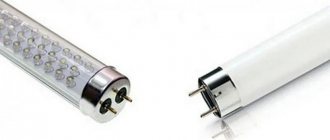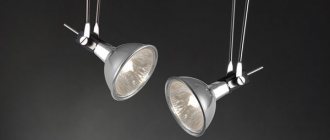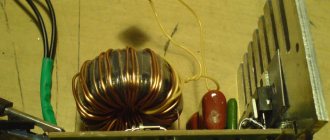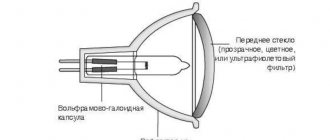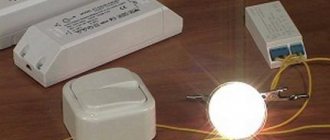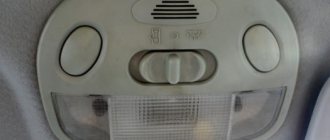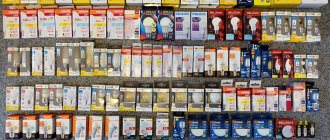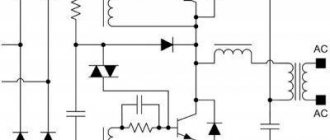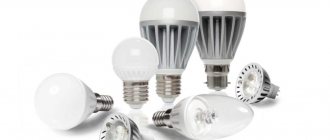On sale you can find very beautiful lamps with miniature halogen lamps. Such lamps are still very popular, since their LED analogues are not produced. But you can buy LED lamps, which, judging by the description, are suitable for them. However, in reality, such a replacement entails problems, the descriptions of which are now filled with many specialized Internet forums. For example, LED lamps quickly fail, give insufficient light, the shade of the glow changes... Is it possible to somehow correct this situation?
The operating principle of halogen incandescent lamps (HLL) involves placing an incandescent filament inside a bulb that is much smaller in size than the bulb of a conventional incandescent lamp. The tungsten deposited on the glass is returned back to the filament through the tungsten-halogen cycle. This circumstance makes it possible to produce so-called capsule GLNs. The peculiarity of their design is that the bulb and base are made of glass, representing a single whole. The small size of capsule GLNs has led to the fact that they are often used in stylish lamps produced under prestigious brands. Famous designers often have a hand in their creation. Even a crystal chandelier, which became a bad manners in post-Soviet times, being made on the basis of capsule GLNs, looks fresh and original.
Types of GLN capsule bases
Capsule GLNs are characterized by pin sockets. In the international notation system, they correspond to the letter G, followed by a number indicating the distance between the pins in millimeters.
G9. Lamps with this base are designed to be connected directly to a 230 V power supply. For widespread use with such a base, GLNs with power from 20 to 75 W are produced (standard range: 20; 25; 40; 50; 60; 75 W).
Capsule GLN with G9 base
G4 . Lamps are available in both 230 and 12 V, but 12 V are most common. G4 lamps, powered directly from the mains, are used mainly in chandeliers originally intended for the US market. The G4 cartridge has less electrical safety than the G9. The G4 socket is recommended for use at a voltage of 12 V or 120 V. However, to ensure compatibility, G4 lamps for 230 V are also produced. The power of lamps with a G4 socket ranges from 10 W to 40 W (standard range: 10; 20; 40 W) .
Capsule GLN with G4 base
G6.35 . Lamps are available for 12 or 230 V. Since in Russia, unlike the two above types, lamps for the G6.35 base and its modification GY6.35 are not widely used, we will not consider it separately in the future. Let us only note that the same recommendations apply to it as for the G4 base.
Technical aspects of installing LEDs instead of halogens
The difficulty in switching from halogen lamps to diodes lies in modifying the power circuit. The power supply for halogen sources provides the voltage required for LEDs at 12 Volts, but does not stabilize it. Without stabilization, the LEDs will flicker, causing eye discomfort that is harmful to health.
You can replace the power supply in several ways:
- Complete replacement of power supplies. Transformers from the chandelier body are replaced with DC converters or LED drivers.
- The simplest option is to replace halogen devices with diodes with installed rectifiers that operate at the same voltage. In this case, replacement of power supplies is not carried out; it is enough to simply install diodes in place of the halogens. An important disadvantage of the method is low illumination due to voltage drop; brightness can be increased with lamps of higher power.
- Selection of LED lamps that operate on 220 Volts. Such sources are connected in parallel from the household network. Auxiliary elements will require step-down transformers. If the lamp operated on 12-volt halogen lamps, and instead of them LEDs with a voltage of 220 V are installed, then the connecting cables will need to be replaced.
The first method is the most reliable and safe, but it is also the most labor-intensive and expensive.
If you use a remote control to operate the chandelier, then with a complete transition to LEDs, it will not be able to control the lamp. This is due to low power consumption.
Problems associated with replacement
The dimensions of a typical capsule GLN with a G9 base are: length - 53 mm, diameter of the cylindrical part - 18 mm. For a G4 base, the typical dimensions of the bulb are: length - 32 mm, diameter - 8 mm. For comparison, a typical incandescent lamp with an E27 base is 110mm high and has a ball diameter of 60mm. Due to their small size, retrofits G9 and G4 can accommodate only the simplest driver, which does not ensure stability of the current flowing through the LEDs. The small dimensions of the case limit the parameters of the components used, for example, the capacitance of smoothing capacitors. The cheapest retrofits G9 and G4 are built using a driverless design characterized by a high level of pulsation. The simplest driver, as well as driverless circuits, require electrical isolation of the LEDs to prevent the user from receiving an electric shock if they accidentally touch them.
Assuming that the LED retrofit should be similar in shape and size to a similar incandescent or GLN lamp, the surface area of the E27 retrofit is approximately 6 times larger than that of G9 and 20 times larger than that of G4. The smaller the surface area, the worse the ability to dissipate heat.
When purchasing, it makes sense to check LED retrofits (at least the pulsation level) in the simplest way - by pointing the smartphone camera. Unfortunately, G9 and G4 retrofits are usually sold in blister packs. When the lamp is removed from the blister for testing, the packaging is destroyed, so returning a serviceable product on the grounds of “didn’t like it” or “selection error” is impossible. In reality, it is possible to make claims about pulsations only if the manufacturer declares their maximum level or reports their absence.
However, it is possible to give a rough estimate of the parameters of the G9 and G4 LED lamps based on their design. The next step may be to purchase one copy for testing, and, if it proves itself well, the missing lamps to the required number.
How to replace a halogen lamp in a spotlight?
Taking into account each requirement, it is not necessary to invite a specialist to replace a halogen light bulb. The algorithm of actions is also simple: remove the fixing ring, remove the halogen light bulb from the socket, but not with bare hands, install a new one and do not forget to secure the lamp body. By turning on the electricity, you will understand whether you performed the actions correctly.
Spotlights also include LEDs; they are considered an excellent analogue, and are also safe and economical.
LED lamps are gradually replacing analogs with higher energy consumption, in particular halogen lamps. If the socket in the lighting fixture matches the base of the light source, it is possible to replace lamps of one type with another. It is easier to install 220 volt LED lighting elements instead of inefficient analogues in a lamp, since the design of such a lamp already includes a current stabilizer.
But if it is necessary to replace the 12-volt halogen model with a version based on diodes with an equivalent supply voltage, in this case there are nuances that you should find out about before installation.
The most common design options for LED lamps G9 and G4 at 230 V
"Classical" . Most of the surface of the case is occupied by a metal or ceramic heat sink, inside of which there is a full-fledged driver. The light source is one powerful LED (Power LED). At the end of the retrofit there is an optical system that ensures light distribution in different directions. Such retrofits meet all the necessary standards, which is why they are produced (Philips, Osram, GE). This type of lamp for 230 V voltage is available only with G9 socket. There is a modification of the design in which at the end of the retrofit there is not one powerful LED with an optical system, but several SMD LEDs directed in different directions.
LED retrofit G9 based on Power LED
"Silicon" . The light source in such lamps is highly efficient SMD LEDs of size 3014. To ensure effective heat dissipation, the control electronics and LEDs are filled with a special type of transparent silicone with increased thermal conductivity. Thus, the entire surface of the lamp body removes heat. The design of the “silicone” lamp allows the use of high-capacity capacitors in it, which can significantly reduce the level of ripple.
Retrofit G9 with silicone filling
The transparent design allows you to check whether the lamp has such a capacitor and even find out its capacity. The maximum luminous flux that such a retrofit can produce is 350 lm, which corresponds to capsule GLNs with a power of up to 35 W. But, if you do not set the task of ensuring compatibility with most lamp models, then using this technology it is possible to produce a G9 lamp with a luminous flux of up to 1200 lm, which corresponds to a 120 W GLN. The dimensions of the case, naturally, will be much larger. In the latest modifications of “silicone” lamps, instead of SMD LEDs, two COB matrices are used, directed in opposite directions.
“Corn” with a protective cap is not the best option in terms of heat dissipation
"Corn" with a protective cap . A “corn” type lamp, in which, due to the use of a driver of the simplest design, there is a danger of electric shock to the user. A transparent plastic cap is used for protection. There may be several small holes in it for air circulation. In corn lamps, cooling of SMD LEDs is usually carried out by free air circulation. The protective cap prevents this circulation, resulting in overheating of the LEDs. Some manufacturers partially solve this problem by adding a small ceramic heat sink. According to the author of the article, the “corn” with a protective cap is the most problematic retrofit design of those being considered. Overheating of LEDs leads to accelerated degradation of the phosphor, which, in turn, leads to deterioration in color rendering.
Regular corn . Such lamps use a full-fledged isolated driver, which prevents electric shock to the user. Thanks to this, there is no need to cover the SMD LEDs with a protective cap. Such lamps are distinguished by their reliability and ability to produce a large luminous flux. Unfortunately, they are much larger in size than similar GLNs, which allows them to be used not in all lamps.
Comparison of halogen lamps with LED lamps while driving
It is not entirely correct to compare from photographs how headlights shine with different types of lamps, since photographs do not reveal the sensations of driving at night. In order to really find out which lamps were better, it was necessary to drive a car at night, with different types of light bulbs.
As a result, as a result of testing, we found that, in comparison with conventional halogen lamps, headlights with LED low beam lamps shine more efficiently.
The only thing we paid attention to when testing while driving was the dispersion range (beam of light). As you can see in the photographs, the brightness of LED lamps significantly exceeds the brightness of halogen lamps (even expensive and powerful ones). But, nevertheless, halogen lamps have a large beam range, which is indispensable while the car is moving. For example, if you are driving in complete darkness, then the illumination range of the road itself plays a significant role in safety
In such driving conditions, the range of the light is more important than its brightness in front of the car
Advantages of LED car low beam lamps
– You can see every small pebble on the road in front of the car within 10-15 meters. Due to the brightness of LED lamps, when driving in the dark, you will feel like the night is over. By the way, this can play an important role when driving for a long time at night. The fact is that the more light there is, the less risk of falling asleep while driving.
– Your headlights will shine very brightly, which increases the visibility of your car on the road to other drivers. Even from a great distance on the highway, your car will be easily seen by other drivers who are moving towards you.
– Reducing the load on the vehicle’s electrical system (including the battery). Especially when you use a car refrigerator or other energy-intensive equipment connected to the car's cigarette lighter.
– Stunning appearance. Yes, the front optics, where LED low beam lamps are installed, look very stylish and beautiful. From a distance, your car will be indistinguishable from expensive premium vehicles.
Disadvantages of LED car low beam lamps
– Despite the correct adjustment of the headlights, LED lamps produce a very bright light, which at close range can blind drivers moving towards you.
– Small range of the light beam. Small dispersion range. This is a big disadvantage for high-speed driving at night. Halogen lamps have a longer illumination range and do not blind oncoming drivers.
– LED lamps that come with retrofit kits and are presented on the automotive market are not entirely legal. So, despite the fact that most LED lamps are certified in Russia, according to current legislation, it is not entirely legal to retrofit a car with LED low-beam lamps if the car manufacturer itself has not provided for this possibility at its factory.
Let us remind you that any changes to the design of the machine that may affect road safety must be certified and approved by the traffic police.
However, despite the fact that the installation of LED low beam lamps is not entirely legal, many drivers in recent years have begun to equip their vehicles with them en masse. This is due to the fact that in most cases the traffic police do not have the opportunity to check on the road what types of lamps are used in the car. As a rule, special equipment is required for this.
The only place where car owners may encounter problems is after installing LED lamps in a technical center, when passing a technical inspection. In accordance with current standards and legislative acts, if lighting elements are installed on a vehicle that do not comply with established GOSTs, then the vehicle will not receive a positive inspection report.
The most common design options for 12 V G4 LED lamps
"Classical" . Usually identical to the same design with a G9 base, but, of course, has different dimensions. Luminous flux up to 200 lm, which corresponds to a capsule GLN with a power of up to 20 W.
"Silicone". Similar to the same design with G9 base, but with different dimensions. Luminous flux up to 300 lm, which corresponds to a capsule GLN with a power of 30 W. If size restrictions are not met, the luminous flux for the G4 base can reach 500 lm.
A promising corn model based on COB
Regular corn . With a supply voltage of 12 V, there is no need to protect the user from electric shock, therefore, in size, such lamps approximately correspond to GLN. G4 retrofits of the “corn” type on SMD LEDs are gradually leaving the market due to their unaesthetic appearance. Instead, retrofits have been produced, in which COB matrices installed on a metal heat sink are used instead of SMD LEDs.
"Flat" . Designed for flat luminaires with reflectors built into furniture. Retrofits are a flat board with SMD LEDs and several electronic components located on it. The gain in energy efficiency is obtained not only due to the use of LEDs, but also due to the glow in only one direction - the lamp reflector, which introduces losses, is not used. Such lamps can easily replace halogen counterparts with a power of up to 20 W.
Retrofit G4, designed for furniture lamps
Benefits of remodeling
In this case you will receive:
energy savings (2 times)
greater illumination
lower losses (almost half of the useful energy in fluorescent lamps can be lost in the choke)
absence of vibration and unpleasant rattling sound from the ballast throttle
True, more modern models already use electronic ballast. They have increased efficiency (90% or more), noise has disappeared, but energy consumption and luminous flux have remained at the same level.
For example, new models of such LPO and LVO are often used for Armstrong ceilings. Here is a rough comparison of their effectiveness:
Another advantage of LEDs is that there are models designed for supply voltages from 85V to 265V. For fluorescent you need 220V or close to it.
For such LEDs, even if your network voltage is low or too high, they will start and shine without any complaints.
Is a replacement possible?
Let's see which lamps can actually be installed in a designer chandelier to ensure good color rendition and reliable quality guarantees. This table contains warm white LED lamps with 230 V G9 and 12 V G4 sockets, which have the highest luminous flux in their category and meet certain criteria. The CRI color rendering index must be at least 80, and the dimensions must ensure compatibility with the most common luminaire models. Of the Russian brands, we chose Navigator and Uniel, since they publicly report the color rendering index of lamps on their websites, and also give a guarantee of at least 2 years for retrofits G9 and G4, like their famous foreign colleagues. Some powerful Navigator models were not considered due to a CRI of 70. The table shows the lamps that could be purchased in Russia as of October 2022.
| Model | Base | Design | Length, mm | Diameter, mm | Power consumption, W | Luminous flux, lm | Equivalent power GLN, W |
| Osram/Ledvance Paraphom P PIN 30 2.6 W/827 G9 | G9 | Classic (SMD) | 52 | 15 | 2,6 | 320 | 30 |
| Philips CorePro LEDcapsuleMV 2.3-25W G9 827 D | G9 | Classic (Power LED) | 51 | 23 | 2,3 | 215 | 25 |
| Navigator NLL-G9-2.5-230-3K-P | G9 | Classic (Power LED) | 46 | 16 | 2,5 | 170 | 17 |
| Uniel LED-JCD-5W/NW/G9/CL/DIM SIZ03TR | G9 | Silicone | 59 | 16 | 5 | 350 | 35 |
| Osram/Ledvance Paraphom P PIN 28 2.4 W/827 G | G4 | Classic (SMD) | 44 | 14 | 2,4 | 300 | 30 |
| Philips CorePro LEDcapsule LV | G4 | Classic (SMD) | 45 | 14 | 2 | 200 | 20 |
| Navigator NLL-S-G4-2.5-12-3K | G4 | Silicone | 36,5 | 10 | 2,5 | 170 | 17 |
| Uniel LED-JC-12/2W/WW/G4/CL SIZ05TR | G4 | Silicone | 38 | 10 | 2 | 150 | 15 (actually)/20 (according to the manufacturer) |
Lamps with a CRI of at least 80 and the highest luminous flux in their category
From the table we can conclude that without problems (after the end of the warranty period of 2-3 years, you may want to completely change the lighting in the house) they can be replaced with GLN LED capsule lamps with a power of up to 35 W with a G9 base and up to 30 W with a base G4. It should be noted that most models of designer chandeliers with a G4 socket provide for the use of GLNs with a power of 10 or 20 W, so now we can already talk about the almost complete replaceability of capsule GLNs with this base for LED ones. But most models of lamps for G9 are designed for GLN with a power of 40 W and higher. The lamps shown in the table do not replace them, although Osram/Ledvance has already announced the release in the near future of a 40 W LED analogue of the GLN G9, which has excellent color rendering and a warranty of at least 2 years.
Features of lamp reinstallation
Before replacing lamps, you need to consider a number of features. For example, if this is an ordinary chandelier with halogen bulbs, there is no provision for reinstalling the light source due to the installed transformer, which converts the standard voltage specifically for “halogen” ones.
Transformer for halogen chandelier.
In this case, you will have to change the chandelier completely. If the LED chip is designed for a lower voltage, it simply will not turn on. Also, some chandeliers have a remote control. If you install other bulbs, it will stop working.
In a spotlight
First, the fixing ring is removed, then you need to remove the device from the cartridge (before doing this, you should put gloves on your hands). The new bulb is then installed, after which the lamp housing is secured in place.
Changing a halogen lamp in a spotlight.
An LED light bulb for a spotlight is considered the best analogue, as it is economical and safe. The displacement of halogens is due to high energy consumption. If the socket in the lamp matches the purchased LED lamp, you can replace one type of product with another.
It is much easier to install an LED analogue instead of a 220-volt halogen lamp, since the design includes a current stabilizer. But if it is necessary to rework the halogens of a 12-volt model with an equivalent supply voltage, difficulties may arise that only a specialist can handle.
In a suspended ceiling
Replacing light bulbs in a suspended ceiling occurs in the following order:
- De-energizing the room.
- Dismantling of internal mechanisms, that is, installing a driver instead of a transformer. This is necessary to convert the 220 V current to the required rating for the LEDs.
- Removing the cartridge.
- Installation of LED lamp.
- If necessary, insulate the wiring.
- Assembly.
Installation of a lamp in a suspended ceiling.
Before turning on the light bulbs, you should double check that everything is installed correctly.
It is important that the transformer works correctly, otherwise it may lead to burnt out diodes
Practical recommendations
When choosing a designer chandelier for capsule GLNs with the purpose of subsequently installing LED lamps in it, it is better to choose a model with G4 sockets. Before purchasing a lamp, select LED lamps in advance and try on how their appearance will fit into the design of the device. The step-down transformer should be replaced with a power supply that provides a stabilized output voltage of 12 V DC. This way you will get zero ripple levels regardless of the design of the lamps. If the lamp is designed for 230 V, convert it to 12 V by installing it at the input of the specified power supply. There is no need to change the wires inside the lamp.
If you already have a chandelier with G9 sockets, replacing the GLN with LED lamps may reduce the luminous flux. Then you should add additional lamps to the room, for example, hang a sconce or point a spotlight at the ceiling.
But for some chandelier models, you will still have to keep the existing capsule halogen lamps until their full-fledged LED analogues appear. Remember, you spent several tens of thousands of rubles on the purchase of a stylish chandelier; does it make sense to save about a hundred or two a month on electricity, distorting the designer’s intention?
©Alexey Vasiliev
Pros and cons of exchanging lamps
Many people try to replace halogen bulbs with LED bulbs in a chandelier, since they work on the same principle as incandescent bulbs. Inside the flask there is a tungsten spiral and a chemical mixture that prevents failure and wear of the product. Power comes from a 12-, 24-volt current source.
Halogen lamp.
The advantage of an LED lamp is that it quickly reaches full power. The brightness of an incandescent, fluorescent or halogen lamp increases gradually. Diodes tolerate voltage surges more easily, especially if it is an expensive and high-quality device.
In addition, safety is important to buyers. The chips are powered by minimal voltage, so the elements do not pose a danger during the replacement process. If an incandescent or halogen light bulb stops working, it cannot be repaired. Speaking of LED devices, it is often enough to simply replace a burnt-out LED with a new one. If you have experience, you can do this yourself.
Disadvantages of LED lamps:
- Over time, the crystal degrades, which reduces the brightness of the glow;
- high price;
- Neutral or cold light suppresses the release of melatonin, which can cause sleep deprivation.
Chinese low-quality products may have poor color performance and high pulsation. Also, buyers often encounter defective devices.
Video: How to choose the right LED lamps.
Is it worth changing
Such changes in the electronic circuit of the chandelier will require a lot of effort, considerable time and financial costs. However, there are a lot of benefits that can be gained from this.
The service life of a halogen lamp is approximately 4000 hours, LED devices - 25-30 thousand hours. Add to this the significant energy savings that are achieved by reducing the power consumed by the chandelier while maintaining the nominal glow intensity. If five 40 W halogen lamps were installed, then the total load was 200 W. In the case of LED products, the load will be 7.5-10 W. Thus, such a replacement is completely rational and justified. In order to save money, LED equipment is used in powerful floodlights installed in stadiums.
Above, we forgot to mention another important parameter taken into account when purchasing LED sources - color temperature. Warm, yellow shades are much more pleasing to the eye, but the whiter the light, the more intense the luminous flux will be. Halogen lamps have approximately the same color temperature - about 2700 K (yellow glow), while for LED lamps the range is significantly higher - from 2500 to 6500 K. As the color temperature increases, the glow becomes brighter and whiter.
Replacing lamps type GX53 (tablet)
The easiest way to change them is:
- holding the lamp body with your left hand, turn the lamp slightly (up to 20 degrees) counterclockwise until it clicks
- then take it out by pulling it down
- installation and fixation of the new one in place occurs by aligning the contacts and turning clockwise. In this case, a characteristic click should also be heard.
There is no need to remove or disassemble the lamp itself.
Features of lamp reinstallation
Before replacing lamps, you need to consider a number of features. For example, if this is an ordinary chandelier with halogen bulbs, there is no provision for reinstalling the light source due to the installed transformer, which converts the standard voltage specifically for “halogen” ones.
Transformer for halogen chandelier.
In this case, you will have to change the chandelier completely. If the LED chip is designed for a lower voltage, it simply will not turn on. Also, some chandeliers have a remote control. If you install other bulbs, it will stop working.
In a spotlight
First, the fixing ring is removed, then you need to remove the device from the cartridge (before doing this, you should put gloves on your hands). The new bulb is then installed, after which the lamp housing is secured in place.
Changing a halogen lamp in a spotlight.
An LED light bulb for a spotlight is considered the best analogue, as it is economical and safe. The displacement of halogens is due to high energy consumption. If the socket in the lamp matches the purchased LED lamp, you can replace one type of product with another.
It is much easier to install an LED analogue instead of a 220-volt halogen lamp, since the design includes a current stabilizer. But if it is necessary to rework the halogens of a 12-volt model with an equivalent supply voltage, difficulties may arise that only a specialist can handle.
In a suspended ceiling
Replacing light bulbs in a suspended ceiling occurs in the following order:
- De-energizing the room.
- Dismantling of internal mechanisms, that is, installing a driver instead of a transformer. This is necessary to convert the 220 V current to the required rating for the LEDs.
- Removing the cartridge.
- Installation of LED lamp.
- If necessary, insulate the wiring.
- Assembly.
Installation of a lamp in a suspended ceiling.
Before turning on the light bulbs, you should double check that everything is installed correctly.
It is important that the transformer works correctly, otherwise it may lead to burnt out diodes
Why won't LED bulbs fit into regular headlights?
Most car headlights are more than just a bulb in a reflector attached to a positive and negative light. This is truly a high-precision system, honed by generations of engineers. In the scientific community, there is even a separate direction for studying the influence of light, the basis of any engineering thought - it’s called photometry.
Photometry is a scientific discipline common to all branches of applied optics, on the basis of which quantitative measurements of the energy characteristics of the radiation field are made.
Intensity, or power of the luminous flux (the unit of luminous intensity is measured in candela), luminous flux , measured in lumens (Lm), illumination , luminous efficiency and many other equally important parameters.
Right down to reflectors (a complex system of mirrors), which have a strictly adjusted shape for each type of light source. For elliptical optics - one, for dual incandescent H4 lamps - another. Well, for LEDs - the third.
And all this so that the light emitted by the lamp hits the road in such a way as to ensure maximum visibility for the driver without blinding oncoming traffic.
Most LEDs do not emit light from the same location in the headlight housing as incandescent bulbs, and from that point on they are doomed to produce mediocre results!

